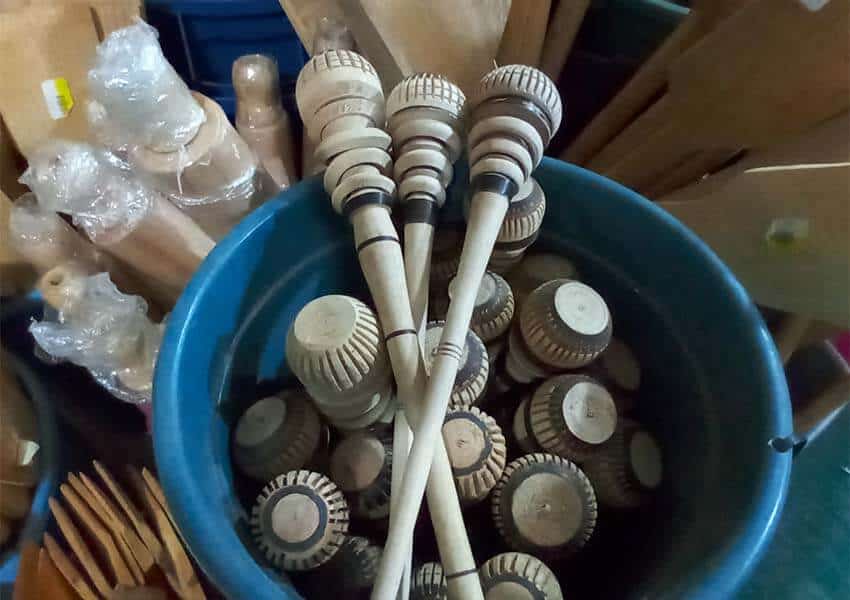The first time I encountered atole was in the days between Christmas and New Year’s, at a stand outside a busy department store in Mazatlán where I’d gone with a local friend to exchange a gift. She was in a hurry; I lingered by the door, watching the vendor ladle the steaming hot something into cups and hand them to appreciative customers. “What is that? I want some!” I wailed as she bundled me into the store and onto the elevator.
Good friend that she is, on the way out, we stopped and she explained about the delicious beverage we were about to try. I’ve never forgotten that first, wonderful taste of atole and what a satisfying drink it is for a chilly winter’s evening.
Since then, I’ve learned much about this ancient pre-Hispanic beverage. The simplest description is that it’s a thick, hot, corn-based drink, sweetened and flavored with everything from cinnamon or vanilla to guava, almonds or citrus zest. (Chocolate atole has its own name: champurrado.) “Corn” as in masa harina, nixtamalized ground dried field corn that’s the basis of tortillas, gorditas, etc.
Popular in many Central American countries, in Mexico you’ll find atole in different flavors specific to different regions, running the gamut from sweet to savory. For example, in Oaxaca, Veracruz and Michoacán, chileatole, a spicy-savory version made with chile and epazote, is common. In northern Mexico, the famed Tarahumara — known all over the world for amazing long-distance runners — have used masa-based, energy-filled pinole as a staple in their diet for thousands of years.
We’re lucky that nowadays we don’t have to grind dried corn; using masa harina para tortillas will yield a fine atole. Do avoid recipes with cornstarch; the result, while admittedly delicious, will not have the same thick consistency that’s part of atole’s charm. (That said, there’s nothing wrong with keeping a few packets of Maizena corn starch in your cupboard for a quick atole-like fix!)

Another fun part of atole is using a traditional wooden molinillo to froth the drink just before serving. My guess is you’ve seen these in your local mercado and didn’t quite know what they were for; or if you did, I bet you’ve never used one.
They come in all sorts of interesting sizes and designs, and while a wire whisk works just as well, a molinillo is a lot more fun!
Champurrado (Chocolate Atole)
Usually a breakfast drink, but equally inviting in late afternoon with a shot of mezcal.
- ½ cup masa harina
- 3 cups water, plus more as needed (see note)
- 1 cup milk
- 3½ oz. dark chocolate, broken into pieces, or chocolate chips
- 3 Tbsp. dark brown sugar/grated piloncillo
- 1 cinnamon stick or ¼ tsp. ground cinnamon
- Salt
Place masa into large saucepan; set over medium heat. Immediately add water in a slow, thin stream, whisking constantly to avoid lumps. Bring to simmer. Whisk in milk, chocolate, sugar and a generous pinch of salt until chocolate is melted, about 1 minute. Add cinnamon.
Return to simmer; lower heat to low. Continue simmering, whisking constantly, about 5 minutes. Discard cinnamon stick. Thin with additional water, as needed, to create a thick yet drinkable beverage.
Add more sugar or salt if desired. Froth with whisk or molinillo.
Atole de Cacahuate (Peanut Atole)
- ½ cup natural smooth peanut butter
- 1 cup milk
- ½ cup masa harina
- 3¼ cups water, plus more as needed
- 3 Tbsp. brown sugar/grated piloncillo
- Salt
Using a blender, combine peanut butter and milk; blend until thoroughly combined. In large saucepan, add masa; set over medium heat. Immediately add water in a slow, thin stream while whisking constantly to avoid lumps. Bring to a simmer; whisk in peanut-milk, brown sugar and generous pinch of salt.
Return to simmer; lower heat to low, then simmer for 3 minutes, whisking constantly. Thin with additional water as needed to create a thick yet drinkable beverage. Add more sugar or salt if desired. Froth with a whisk or molinillo. Serve hot.

Orange Atole
Feel free to use lemon or lime instead of orange.
- ½ cup masa harina
- 3 cups water, plus more as needed, divided (see note)
- 1 cup milk
- 3 (1-inch) strips orange zest from 1 large orange
- 3 Tbsp. grated piloncillo/brown sugar
- Salt
- Finely grated orange zest, for garnish
- Optional: 2 star anise pods
Pour masa in large saucepan; set over medium heat. Immediately add water in a slow, thin stream, whisking constantly to avoid lumps. Bring to a simmer.
Whisk in milk, zest strips, star anise (if using), sugar and generous pinch of salt. Return to a simmer; lower heat to low. Continue simmering about 5 minutes, whisking constantly, until drink is infused with orange aroma.
Discard zest and star anise. Thin with additional water as needed to create a thick yet drinkable beverage. Add more sugar or salt if desired. Froth with whisk or molinillo. Garnish with grated orange zest.
Cinnamon-Vanilla Atole
This is a simpler recipe; use the method above if it feels more comfortable.
- ½ cup masa harina
- 3 cups milk
- ¼ cup water
- 1/3 cup grated piloncillo/brown sugar
- 1 tsp. cinnamon + more for garnish
- 1 tsp. vanilla
Combine masa, water, milk, sugar and cinnamon, whisking constantly over low heat to prevent lumps. After 5–10 minutes, remove from heat; whisk in vanilla. Garnish each cup with cinnamon.
Janet Blaser is the author of the best-selling book, Why We Left: An Anthology of American Women Expats, featured on CNBC and MarketWatch. She has lived in Mexico since 2006. You can find her on Facebook.
